Case Study: Analysis of Nursing Standards and Patient Care Outcomes
VerifiedAdded on 2022/10/01
|7
|1626
|117
Case Study
AI Summary
This case study analyzes a clinical incident involving a patient who presented with severe dehydration, abdominal pain, and dizziness. The nursing staff's failure to promptly address the patient's deteriorating condition, including delayed assessment, lack of documentation, and poor communication, led to a critical outcome. The analysis highlights key contributing factors such as a lack of ethical focus, delayed intervention, improper documentation, insufficient team effort, and a lack of dedication among staff. The study emphasizes the importance of adhering to nursing practice standards, prompt interventions, and effective communication. It suggests implications for future practice, including improved training on nursing guidelines, ethical practices, and team collaboration. The case study underscores the need for specialized staff, advanced communication methods, and continuous professional development to prevent similar incidents and ensure optimal patient care.
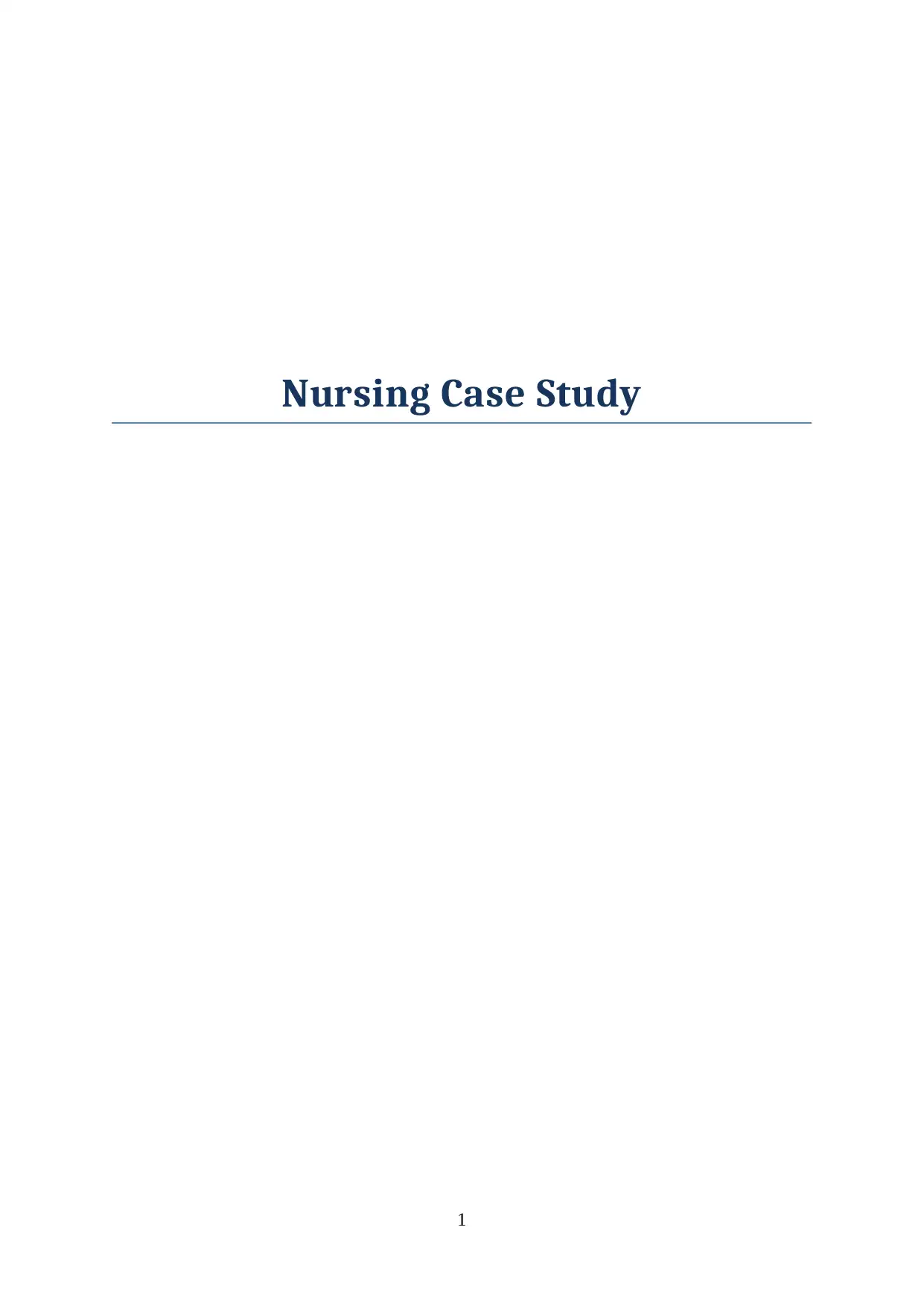
Nursing Case Study
1
1
Paraphrase This Document
Need a fresh take? Get an instant paraphrase of this document with our AI Paraphraser
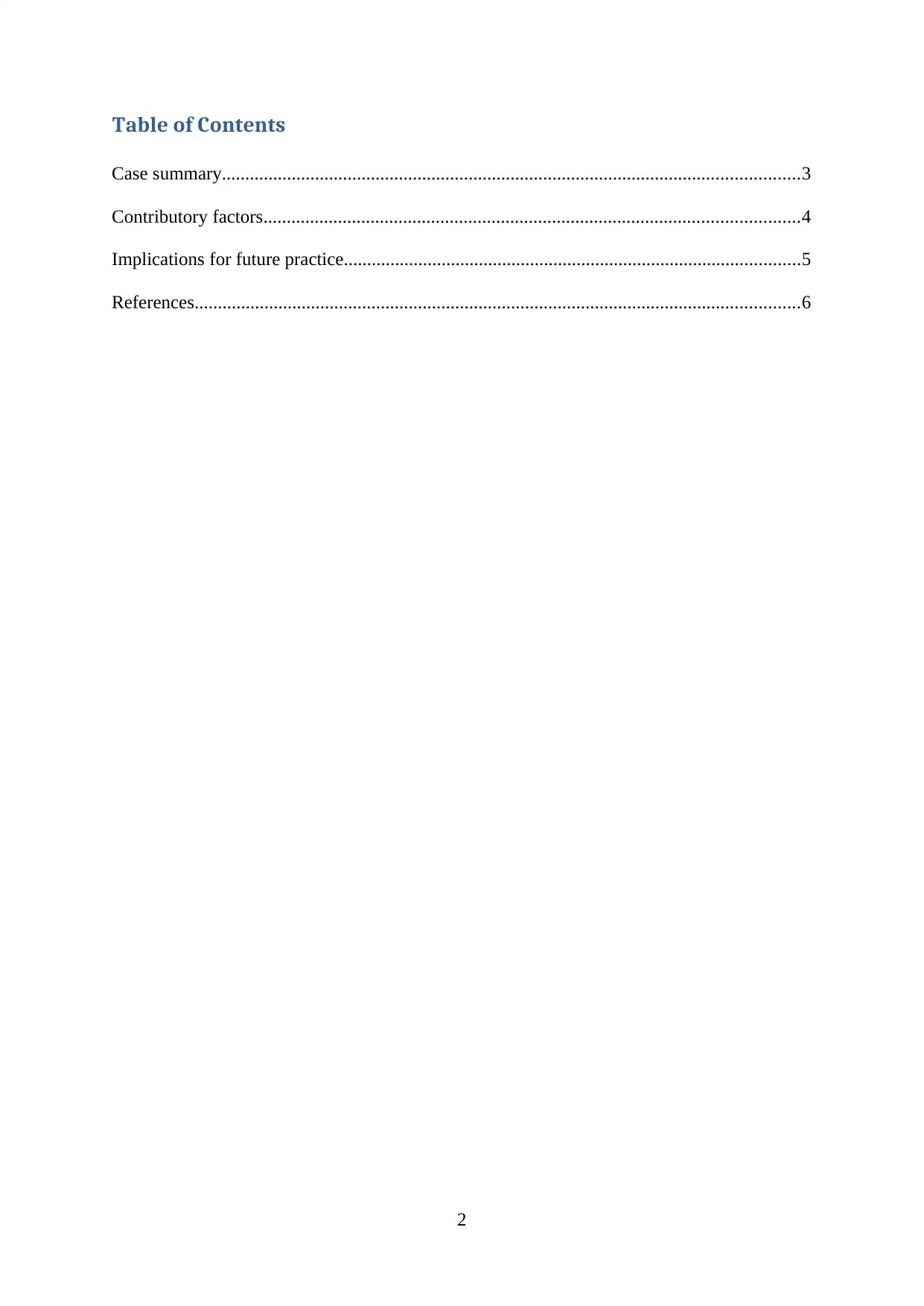
Table of Contents
Case summary............................................................................................................................3
Contributory factors...................................................................................................................4
Implications for future practice..................................................................................................5
References..................................................................................................................................6
2
Case summary............................................................................................................................3
Contributory factors...................................................................................................................4
Implications for future practice..................................................................................................5
References..................................................................................................................................6
2
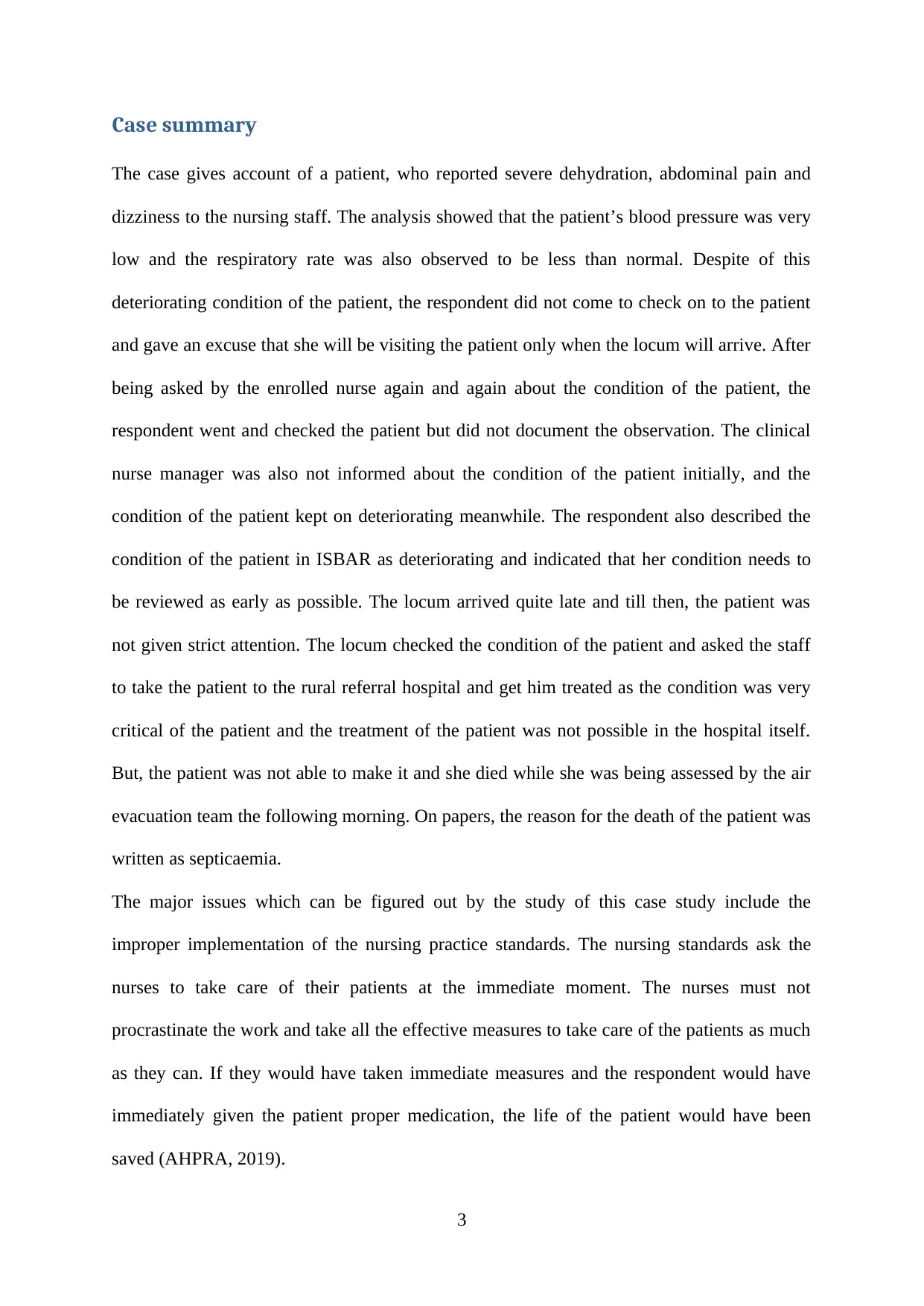
Case summary
The case gives account of a patient, who reported severe dehydration, abdominal pain and
dizziness to the nursing staff. The analysis showed that the patient’s blood pressure was very
low and the respiratory rate was also observed to be less than normal. Despite of this
deteriorating condition of the patient, the respondent did not come to check on to the patient
and gave an excuse that she will be visiting the patient only when the locum will arrive. After
being asked by the enrolled nurse again and again about the condition of the patient, the
respondent went and checked the patient but did not document the observation. The clinical
nurse manager was also not informed about the condition of the patient initially, and the
condition of the patient kept on deteriorating meanwhile. The respondent also described the
condition of the patient in ISBAR as deteriorating and indicated that her condition needs to
be reviewed as early as possible. The locum arrived quite late and till then, the patient was
not given strict attention. The locum checked the condition of the patient and asked the staff
to take the patient to the rural referral hospital and get him treated as the condition was very
critical of the patient and the treatment of the patient was not possible in the hospital itself.
But, the patient was not able to make it and she died while she was being assessed by the air
evacuation team the following morning. On papers, the reason for the death of the patient was
written as septicaemia.
The major issues which can be figured out by the study of this case study include the
improper implementation of the nursing practice standards. The nursing standards ask the
nurses to take care of their patients at the immediate moment. The nurses must not
procrastinate the work and take all the effective measures to take care of the patients as much
as they can. If they would have taken immediate measures and the respondent would have
immediately given the patient proper medication, the life of the patient would have been
saved (AHPRA, 2019).
3
The case gives account of a patient, who reported severe dehydration, abdominal pain and
dizziness to the nursing staff. The analysis showed that the patient’s blood pressure was very
low and the respiratory rate was also observed to be less than normal. Despite of this
deteriorating condition of the patient, the respondent did not come to check on to the patient
and gave an excuse that she will be visiting the patient only when the locum will arrive. After
being asked by the enrolled nurse again and again about the condition of the patient, the
respondent went and checked the patient but did not document the observation. The clinical
nurse manager was also not informed about the condition of the patient initially, and the
condition of the patient kept on deteriorating meanwhile. The respondent also described the
condition of the patient in ISBAR as deteriorating and indicated that her condition needs to
be reviewed as early as possible. The locum arrived quite late and till then, the patient was
not given strict attention. The locum checked the condition of the patient and asked the staff
to take the patient to the rural referral hospital and get him treated as the condition was very
critical of the patient and the treatment of the patient was not possible in the hospital itself.
But, the patient was not able to make it and she died while she was being assessed by the air
evacuation team the following morning. On papers, the reason for the death of the patient was
written as septicaemia.
The major issues which can be figured out by the study of this case study include the
improper implementation of the nursing practice standards. The nursing standards ask the
nurses to take care of their patients at the immediate moment. The nurses must not
procrastinate the work and take all the effective measures to take care of the patients as much
as they can. If they would have taken immediate measures and the respondent would have
immediately given the patient proper medication, the life of the patient would have been
saved (AHPRA, 2019).
3
⊘ This is a preview!⊘
Do you want full access?
Subscribe today to unlock all pages.

Trusted by 1+ million students worldwide
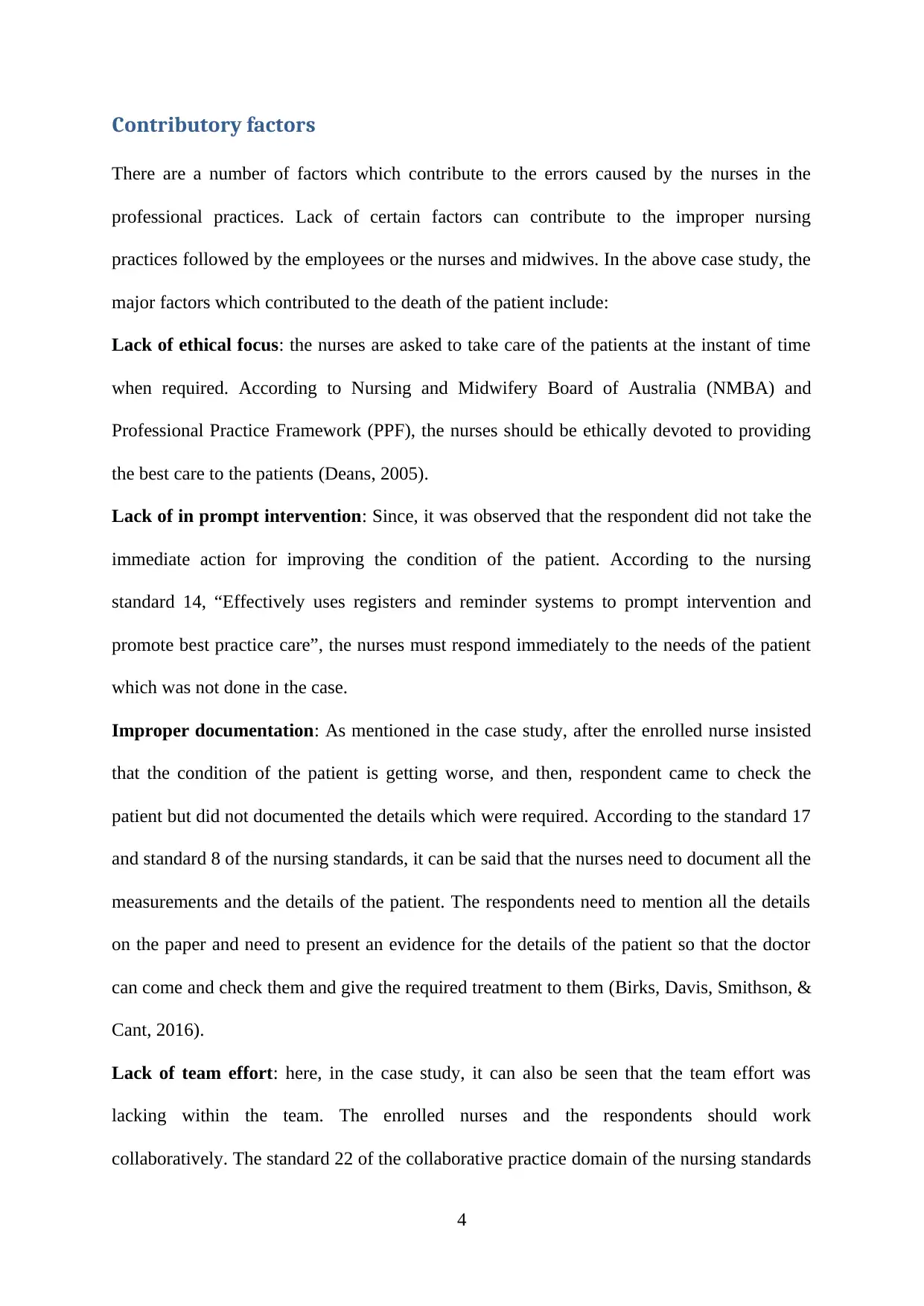
Contributory factors
There are a number of factors which contribute to the errors caused by the nurses in the
professional practices. Lack of certain factors can contribute to the improper nursing
practices followed by the employees or the nurses and midwives. In the above case study, the
major factors which contributed to the death of the patient include:
Lack of ethical focus: the nurses are asked to take care of the patients at the instant of time
when required. According to Nursing and Midwifery Board of Australia (NMBA) and
Professional Practice Framework (PPF), the nurses should be ethically devoted to providing
the best care to the patients (Deans, 2005).
Lack of in prompt intervention: Since, it was observed that the respondent did not take the
immediate action for improving the condition of the patient. According to the nursing
standard 14, “Effectively uses registers and reminder systems to prompt intervention and
promote best practice care”, the nurses must respond immediately to the needs of the patient
which was not done in the case.
Improper documentation: As mentioned in the case study, after the enrolled nurse insisted
that the condition of the patient is getting worse, and then, respondent came to check the
patient but did not documented the details which were required. According to the standard 17
and standard 8 of the nursing standards, it can be said that the nurses need to document all the
measurements and the details of the patient. The respondents need to mention all the details
on the paper and need to present an evidence for the details of the patient so that the doctor
can come and check them and give the required treatment to them (Birks, Davis, Smithson, &
Cant, 2016).
Lack of team effort: here, in the case study, it can also be seen that the team effort was
lacking within the team. The enrolled nurses and the respondents should work
collaboratively. The standard 22 of the collaborative practice domain of the nursing standards
4
There are a number of factors which contribute to the errors caused by the nurses in the
professional practices. Lack of certain factors can contribute to the improper nursing
practices followed by the employees or the nurses and midwives. In the above case study, the
major factors which contributed to the death of the patient include:
Lack of ethical focus: the nurses are asked to take care of the patients at the instant of time
when required. According to Nursing and Midwifery Board of Australia (NMBA) and
Professional Practice Framework (PPF), the nurses should be ethically devoted to providing
the best care to the patients (Deans, 2005).
Lack of in prompt intervention: Since, it was observed that the respondent did not take the
immediate action for improving the condition of the patient. According to the nursing
standard 14, “Effectively uses registers and reminder systems to prompt intervention and
promote best practice care”, the nurses must respond immediately to the needs of the patient
which was not done in the case.
Improper documentation: As mentioned in the case study, after the enrolled nurse insisted
that the condition of the patient is getting worse, and then, respondent came to check the
patient but did not documented the details which were required. According to the standard 17
and standard 8 of the nursing standards, it can be said that the nurses need to document all the
measurements and the details of the patient. The respondents need to mention all the details
on the paper and need to present an evidence for the details of the patient so that the doctor
can come and check them and give the required treatment to them (Birks, Davis, Smithson, &
Cant, 2016).
Lack of team effort: here, in the case study, it can also be seen that the team effort was
lacking within the team. The enrolled nurses and the respondents should work
collaboratively. The standard 22 of the collaborative practice domain of the nursing standards
4
Paraphrase This Document
Need a fresh take? Get an instant paraphrase of this document with our AI Paraphraser
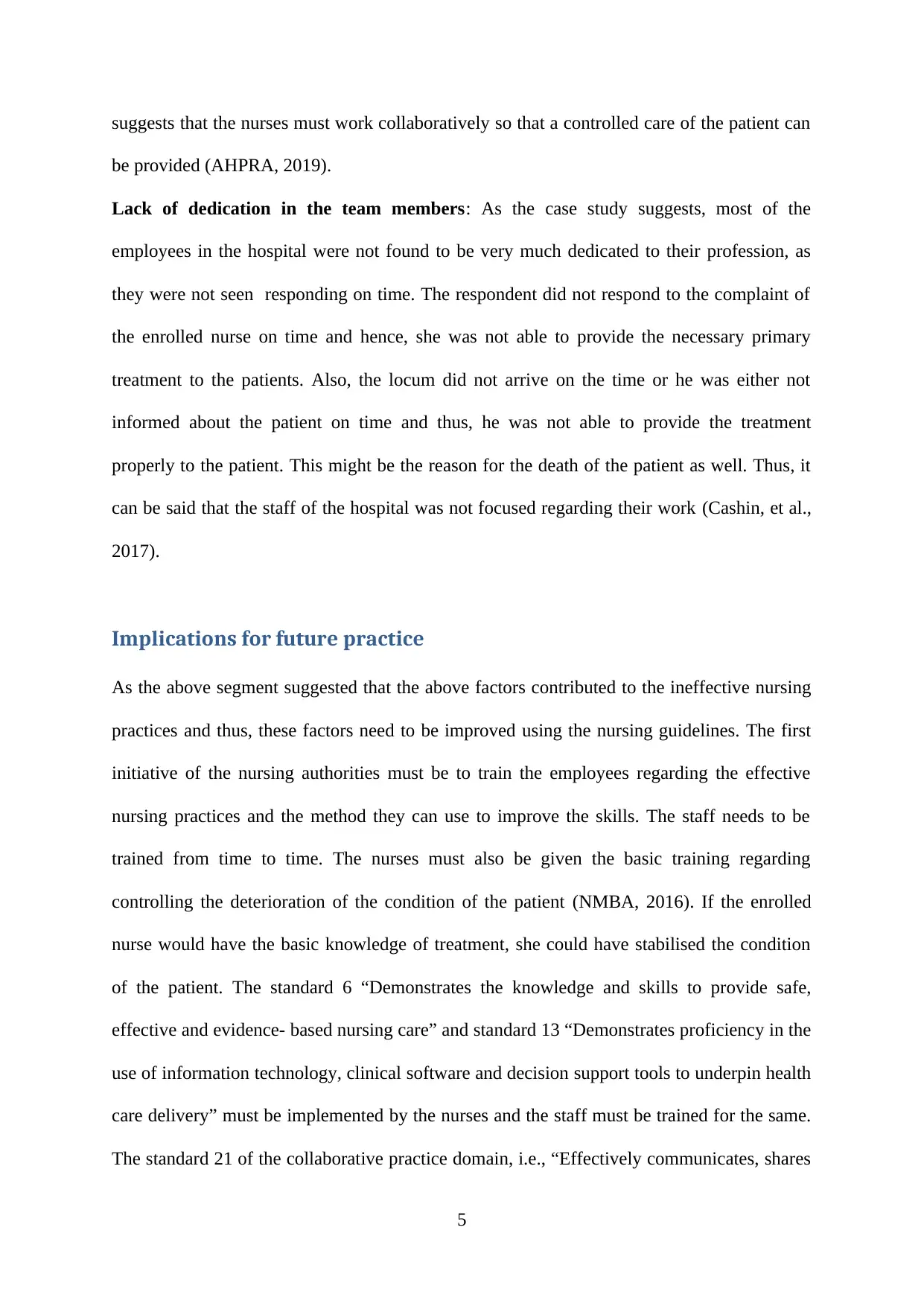
suggests that the nurses must work collaboratively so that a controlled care of the patient can
be provided (AHPRA, 2019).
Lack of dedication in the team members: As the case study suggests, most of the
employees in the hospital were not found to be very much dedicated to their profession, as
they were not seen responding on time. The respondent did not respond to the complaint of
the enrolled nurse on time and hence, she was not able to provide the necessary primary
treatment to the patients. Also, the locum did not arrive on the time or he was either not
informed about the patient on time and thus, he was not able to provide the treatment
properly to the patient. This might be the reason for the death of the patient as well. Thus, it
can be said that the staff of the hospital was not focused regarding their work (Cashin, et al.,
2017).
Implications for future practice
As the above segment suggested that the above factors contributed to the ineffective nursing
practices and thus, these factors need to be improved using the nursing guidelines. The first
initiative of the nursing authorities must be to train the employees regarding the effective
nursing practices and the method they can use to improve the skills. The staff needs to be
trained from time to time. The nurses must also be given the basic training regarding
controlling the deterioration of the condition of the patient (NMBA, 2016). If the enrolled
nurse would have the basic knowledge of treatment, she could have stabilised the condition
of the patient. The standard 6 “Demonstrates the knowledge and skills to provide safe,
effective and evidence- based nursing care” and standard 13 “Demonstrates proficiency in the
use of information technology, clinical software and decision support tools to underpin health
care delivery” must be implemented by the nurses and the staff must be trained for the same.
The standard 21 of the collaborative practice domain, i.e., “Effectively communicates, shares
5
be provided (AHPRA, 2019).
Lack of dedication in the team members: As the case study suggests, most of the
employees in the hospital were not found to be very much dedicated to their profession, as
they were not seen responding on time. The respondent did not respond to the complaint of
the enrolled nurse on time and hence, she was not able to provide the necessary primary
treatment to the patients. Also, the locum did not arrive on the time or he was either not
informed about the patient on time and thus, he was not able to provide the treatment
properly to the patient. This might be the reason for the death of the patient as well. Thus, it
can be said that the staff of the hospital was not focused regarding their work (Cashin, et al.,
2017).
Implications for future practice
As the above segment suggested that the above factors contributed to the ineffective nursing
practices and thus, these factors need to be improved using the nursing guidelines. The first
initiative of the nursing authorities must be to train the employees regarding the effective
nursing practices and the method they can use to improve the skills. The staff needs to be
trained from time to time. The nurses must also be given the basic training regarding
controlling the deterioration of the condition of the patient (NMBA, 2016). If the enrolled
nurse would have the basic knowledge of treatment, she could have stabilised the condition
of the patient. The standard 6 “Demonstrates the knowledge and skills to provide safe,
effective and evidence- based nursing care” and standard 13 “Demonstrates proficiency in the
use of information technology, clinical software and decision support tools to underpin health
care delivery” must be implemented by the nurses and the staff must be trained for the same.
The standard 21 of the collaborative practice domain, i.e., “Effectively communicates, shares
5
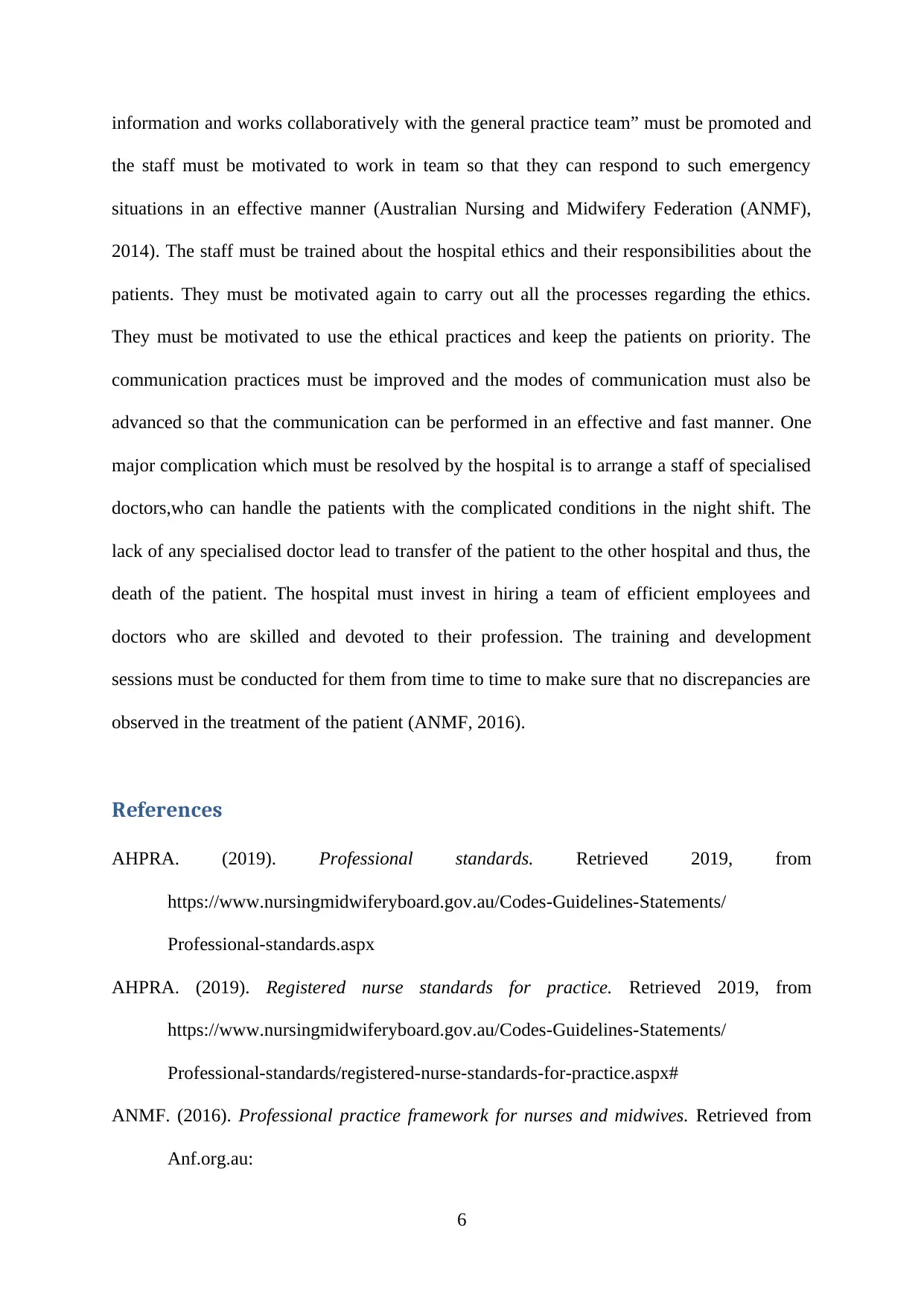
information and works collaboratively with the general practice team” must be promoted and
the staff must be motivated to work in team so that they can respond to such emergency
situations in an effective manner (Australian Nursing and Midwifery Federation (ANMF),
2014). The staff must be trained about the hospital ethics and their responsibilities about the
patients. They must be motivated again to carry out all the processes regarding the ethics.
They must be motivated to use the ethical practices and keep the patients on priority. The
communication practices must be improved and the modes of communication must also be
advanced so that the communication can be performed in an effective and fast manner. One
major complication which must be resolved by the hospital is to arrange a staff of specialised
doctors,who can handle the patients with the complicated conditions in the night shift. The
lack of any specialised doctor lead to transfer of the patient to the other hospital and thus, the
death of the patient. The hospital must invest in hiring a team of efficient employees and
doctors who are skilled and devoted to their profession. The training and development
sessions must be conducted for them from time to time to make sure that no discrepancies are
observed in the treatment of the patient (ANMF, 2016).
References
AHPRA. (2019). Professional standards. Retrieved 2019, from
https://www.nursingmidwiferyboard.gov.au/Codes-Guidelines-Statements/
Professional-standards.aspx
AHPRA. (2019). Registered nurse standards for practice. Retrieved 2019, from
https://www.nursingmidwiferyboard.gov.au/Codes-Guidelines-Statements/
Professional-standards/registered-nurse-standards-for-practice.aspx#
ANMF. (2016). Professional practice framework for nurses and midwives. Retrieved from
Anf.org.au:
6
the staff must be motivated to work in team so that they can respond to such emergency
situations in an effective manner (Australian Nursing and Midwifery Federation (ANMF),
2014). The staff must be trained about the hospital ethics and their responsibilities about the
patients. They must be motivated again to carry out all the processes regarding the ethics.
They must be motivated to use the ethical practices and keep the patients on priority. The
communication practices must be improved and the modes of communication must also be
advanced so that the communication can be performed in an effective and fast manner. One
major complication which must be resolved by the hospital is to arrange a staff of specialised
doctors,who can handle the patients with the complicated conditions in the night shift. The
lack of any specialised doctor lead to transfer of the patient to the other hospital and thus, the
death of the patient. The hospital must invest in hiring a team of efficient employees and
doctors who are skilled and devoted to their profession. The training and development
sessions must be conducted for them from time to time to make sure that no discrepancies are
observed in the treatment of the patient (ANMF, 2016).
References
AHPRA. (2019). Professional standards. Retrieved 2019, from
https://www.nursingmidwiferyboard.gov.au/Codes-Guidelines-Statements/
Professional-standards.aspx
AHPRA. (2019). Registered nurse standards for practice. Retrieved 2019, from
https://www.nursingmidwiferyboard.gov.au/Codes-Guidelines-Statements/
Professional-standards/registered-nurse-standards-for-practice.aspx#
ANMF. (2016). Professional practice framework for nurses and midwives. Retrieved from
Anf.org.au:
6
⊘ This is a preview!⊘
Do you want full access?
Subscribe today to unlock all pages.

Trusted by 1+ million students worldwide
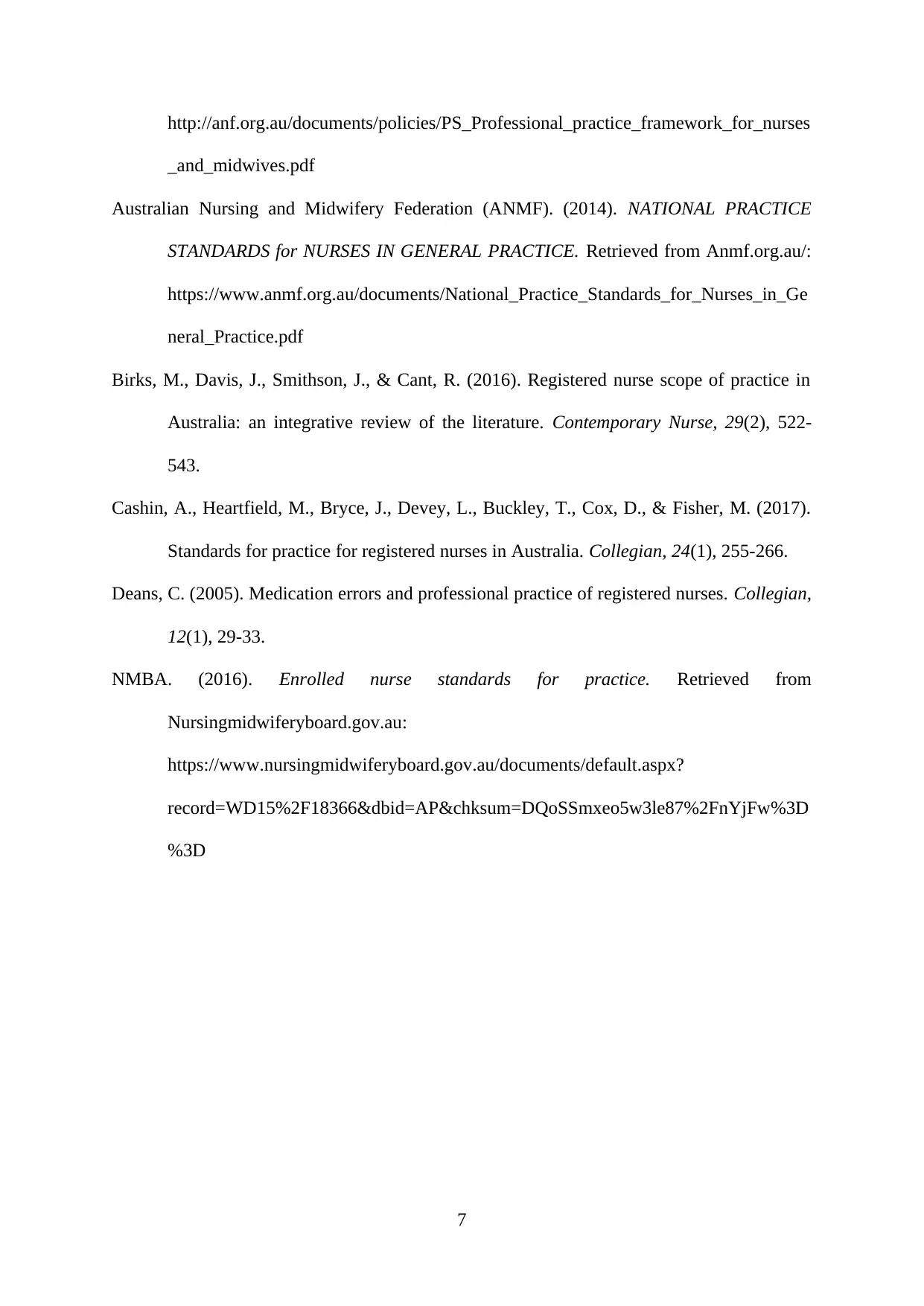
http://anf.org.au/documents/policies/PS_Professional_practice_framework_for_nurses
_and_midwives.pdf
Australian Nursing and Midwifery Federation (ANMF). (2014). NATIONAL PRACTICE
STANDARDS for NURSES IN GENERAL PRACTICE. Retrieved from Anmf.org.au/:
https://www.anmf.org.au/documents/National_Practice_Standards_for_Nurses_in_Ge
neral_Practice.pdf
Birks, M., Davis, J., Smithson, J., & Cant, R. (2016). Registered nurse scope of practice in
Australia: an integrative review of the literature. Contemporary Nurse, 29(2), 522-
543.
Cashin, A., Heartfield, M., Bryce, J., Devey, L., Buckley, T., Cox, D., & Fisher, M. (2017).
Standards for practice for registered nurses in Australia. Collegian, 24(1), 255-266.
Deans, C. (2005). Medication errors and professional practice of registered nurses. Collegian,
12(1), 29-33.
NMBA. (2016). Enrolled nurse standards for practice. Retrieved from
Nursingmidwiferyboard.gov.au:
https://www.nursingmidwiferyboard.gov.au/documents/default.aspx?
record=WD15%2F18366&dbid=AP&chksum=DQoSSmxeo5w3le87%2FnYjFw%3D
%3D
7
_and_midwives.pdf
Australian Nursing and Midwifery Federation (ANMF). (2014). NATIONAL PRACTICE
STANDARDS for NURSES IN GENERAL PRACTICE. Retrieved from Anmf.org.au/:
https://www.anmf.org.au/documents/National_Practice_Standards_for_Nurses_in_Ge
neral_Practice.pdf
Birks, M., Davis, J., Smithson, J., & Cant, R. (2016). Registered nurse scope of practice in
Australia: an integrative review of the literature. Contemporary Nurse, 29(2), 522-
543.
Cashin, A., Heartfield, M., Bryce, J., Devey, L., Buckley, T., Cox, D., & Fisher, M. (2017).
Standards for practice for registered nurses in Australia. Collegian, 24(1), 255-266.
Deans, C. (2005). Medication errors and professional practice of registered nurses. Collegian,
12(1), 29-33.
NMBA. (2016). Enrolled nurse standards for practice. Retrieved from
Nursingmidwiferyboard.gov.au:
https://www.nursingmidwiferyboard.gov.au/documents/default.aspx?
record=WD15%2F18366&dbid=AP&chksum=DQoSSmxeo5w3le87%2FnYjFw%3D
%3D
7
1 out of 7
Related Documents
Your All-in-One AI-Powered Toolkit for Academic Success.
+13062052269
info@desklib.com
Available 24*7 on WhatsApp / Email
![[object Object]](/_next/static/media/star-bottom.7253800d.svg)
Unlock your academic potential
Copyright © 2020–2025 A2Z Services. All Rights Reserved. Developed and managed by ZUCOL.





